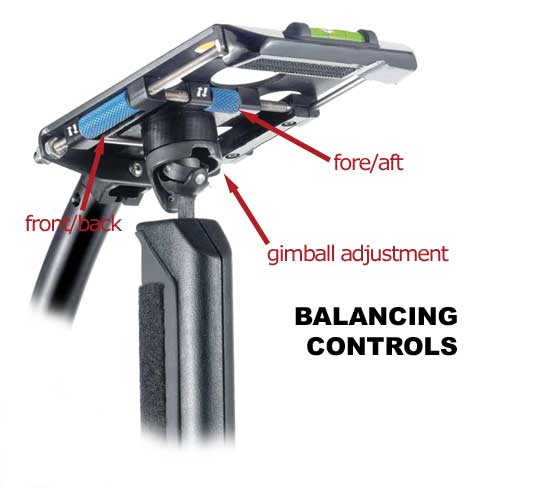June 5, 2006
Tiffen
http://www.steadicam.com/handheldmerlin.html
$849.00
Review by David A. Saraceno
Tiffen's diminutive Steadicam Merlin was a pleasant surprise, both in delivery and performance. The zippered soft case and fitted foam neatly held the device, stainless steel balance weights, dovetail mounting plate, screws, manual, and instructional DVD. A certificate of authenticity personally signed by its designer, award winning Garret Brown, was included. The Merlin, sans cam and weights, was an impressive 13 ounces. It was something that you might find in a Sharper Image or Apple Store.

The unit is approximately 14 inches fully extended, and has a folding (and locking) caliper hinge that separates the lower and upper spars. While designed for camcorders that weigh less than five pounds (2.27kg), I tested it with a Panasonic HVX200 and the Sony Z1U, both of which exceed this weight. Tiffen notes at its web site that the Merlin has been successfully used with these cams, but with medium weight batteries and no accessories. I followed a similar configuration with a Panasonic HVX200.
I also tested it with the much smaller and lighter Sony A1U HDV camcorder and produced some very good results. In all cases, however, you have to learn to balance the Merlin, and practice your technique for shooting footage. Both require some time and dedication (and with the latter, arm strength), but the results can be impressive.
My initial attempts to balance the device with a Sony Z1U and HVX200 were unsuccessful. I contacted the company for assistance and it came in the form of a telephone call from the Merlin's inventor, Garrett Brown. He diagnosed the problem as a faulty caliper hinge, and arranged to have the unit replaced by Tiffen. The new unit worked as advertised.
Panasonic HVX200. This camcorder weighs approximately 5.5 pounds with the large battery, one 8Gb p2 card in the top p2 slot and no additional accessories. I opted for a smaller sized battery in my testing, because the stock battery still made the Panny a little top heavy. Other Panny users report, however, that you can use a stock Panasonic with the Merlin with the larger battery. They add a couple of large metal washers between the lower weights. Tiffen advises against this procedure because it affects the overall rigidity and the precision milled nature of the Merlin.
There are a number of resources to assist in balancing your camcorder with the Merlin. Along with the manual and included DVD is Tiffen's "Merlin Cookbook" located on the web. (http://www.merlincookbook.com/). This excellent database includes dozens of settings for various camcorders configured by Tiffen and submitted by users. Using this guide, I attached the HVX200 to the dovetail plate using camera alignment pin and the locating screw in the "H" hole.
Notably, you can manually identify the balance point using a procedure set forth in the instructional DVD. Or you can use an interactive web based spreadsheet called the "Magic Formula" to input specific information about your camcorder. There is also a downloadable spreadsheet with formulas to assist you. The point being that Tiffen has worked hard to make the balancing act as painless as possible.
With the Panasonic, the upper and lower spars were fully extended and locked into position at 13.5 inches from the trim stage. The Panasonic requires that all balance weights be used due to its top-heavy nature.

With lighter camcorders, the number of balance weights and the extension of the spars are modified accordingly. The on line Cookbook contains Tiffen's suggestions on what weight, initial extension, and trim stage positions should be used. And as I stated earlier, users also supply settings that have worked for their camcorders at the web site.
Perfecting the balance of the Merlin with your camcorder is a trial and error procedure using three adjustable mechanisms -- two precision trim rollers, and the gimbal handle that can be rotated several turns.

If the cam leans up or down, adjust the trim roller on the left side of the Merlin to bring the cam into balance front to back. Use the same procedure with middle trim roller to adjust the side-to-side balance. Both controls are well constructed, easy to use, and responsive. This final balancing act, however, is invariably part art and part science, and it takes some practice for the uninitiated. But surprisingly, once you get the knack of the procedure, it stays with you like riding a bicycle.
The Merlin, however, is not for everyone, nor is it appropriate for every camcorder. It is best suited for lighter cams. Anything in excess of 5.5 pounds requires modifications the Merlin is not designed to accept. Even though it will work at this weight, you must be strong enough to control it for any substantial video shoot. However, the footage is produces with an over cranked HVX200 at 720/24pn (60) is absolutely stunning in my view.
The inevitable question is how much footage can you take with the Merlin. The answer depends on how much combined weight is involved. At nearly eight (8) pounds, my HVX200 was heavy and difficult to use after a couple of minutes. However, the upside is that the footage was pleasing, and my right arm got a good work out. Tiffen reminds users that most Steadicam commercial footage lasts less than two minutes.
Some purchasers may be legitimately concerned with the $849.00 price of the Merlin. However, the unit is remarkably manufactured. It consists of machined aluminum, brass and stainless steel. It is exceptionally rigid which contributes to its overall steadiness in operation. As I said, this should be sold in Apple Stores.
David
A. Saraceno is a motion graphics
artist located in Spokane, Washington. He has written for DV
Magazine, AV Video, MacHome Journal, and several state and national
legal technology magazines. David also moderates several forums
on 2-pop.com.